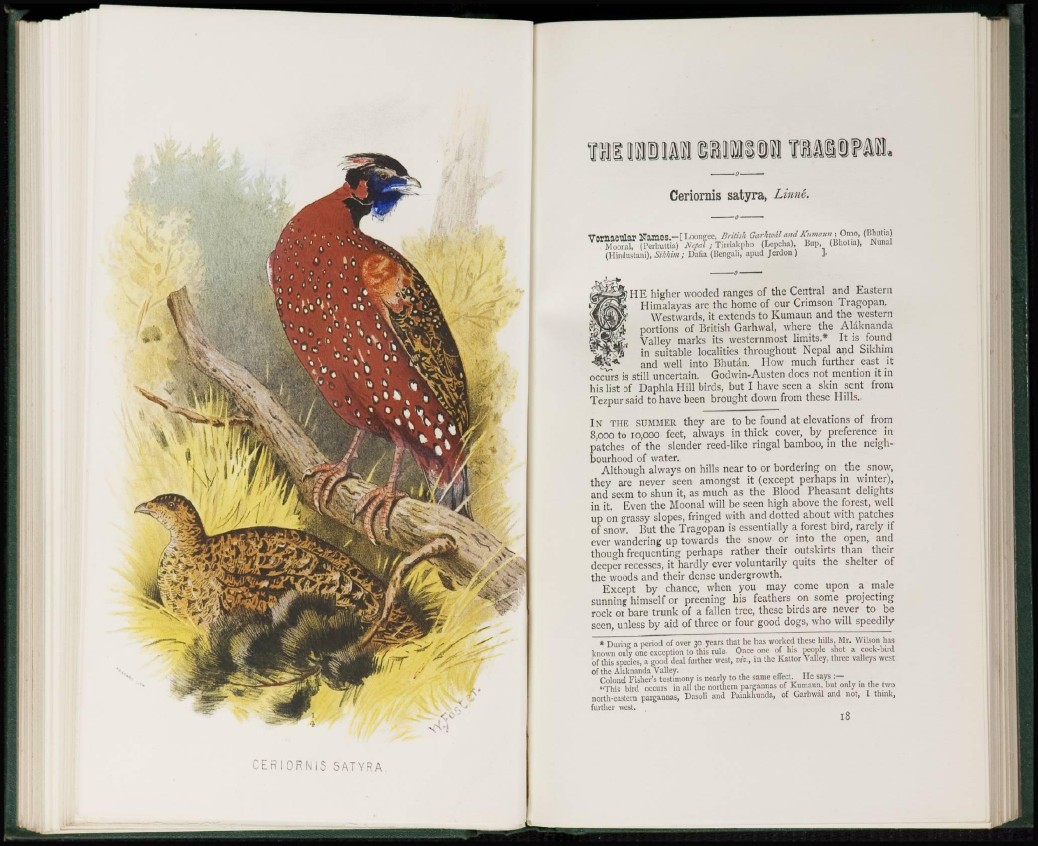
C E R I O R N I S SATYRA
rat imm dwmn WMHXL
Ceriornis satyra, Linni.
VOrnaCUlar Names.—[ Loongee, British Garhwdl andKumaun i Omo, (Btmlia)
Moonal, (Ferbuttia) NtftA ; Tirriakpho (Lepcha), Bop, (Bholia), Nunal
(Hindustani), Sikhirn ; Daiia (Bengali, apud Jerdon ) ],
HE higher wooded ranges of the Central and Eastern
Himalayas are the home of our Crimson Tragopan.
Westwards, it extends to Kumaun and the western
portions of British Garhwal, where the Alaknanda
Valley marks its westernmost limits.* It is found
in suitable localities throughout Nepal and Sikhim
and well into Bhutan. How much further cast it
occurs is still uncertain. Godwin-Austen does not mention it in
bis list of Daphla Hill birds, but I have seen a skin sent from
Tezpur said to have been brought down from these Hills.
I N THE SUMMER they are to be found at elevations of from
8,000 to 10,000 fect, always in thick cover, by preference in
patches of the slender reed-like ringal bamboo, in the neighbourhood
of water.
Although always on hills near to or bordering on the snow,
they are never seen amongst it (except perhaps in winter),
and seem to shun it, as much as the Blood Pheasant delights
in it. Even the Moonal will be seen high above the forest, well
up on grassy slopes, fringed with and dotted about with patches
of snow. But the Tragopan is essentially a forest bird, rarely if
ever wandering up towards the snow or into the open, and
though frequenting perhaps rather their outskirts than their
deeper recesses, it hardly ever voluntarily quits the shelter of
the woods and their dense undergrowth.
Except by chance, when you may come upon a male
sunning himself or preening his feathers on some projecting
rock or bare trunk of a fallen tree, these birds are never to be
seen, unless by aid of three or four good dogs, who will speedily
* During a period of over 30 years that he has worked these hills, Mr. Wilson has
known only one exception to this rule. Once one of his people shot a cock-bird
of this species, a good deal further west, viz., in the Kaltor Valley, three valleys west
of the Alaknanda Valley.
Colonel Fisher's testimony is nearly to the same effect. He says :—
'•This bird occurs iit all the northern pargannas of Kumaun. but only in the two
north-eastern pargannas, Dasoli and Pahikhunda, of Garhwal and not, I think,
further west.